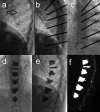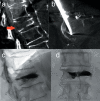Image-Guided Bone Consolidation in Oncology
- PMID: 30402004
- PMCID: PMC6218251
- DOI: 10.1055/s-0038-1669468
Image-Guided Bone Consolidation in Oncology
Abstract
Occurrence of bone metastases is a common event in oncology. Bone metastases are associated with pain, functional impairment, and fractures, particularly when weight-bearing bones are involved. Management of bone metastases has been improved by the development of various interventional radiology consolidation techniques. Cementoplasty is based on injection of acrylic cement into a weakened bone to reinforce it and to control pain. This minimally invasive technique has proven its efficacy for flat bone submitted to compression forces. However, resistance to torsion forces is limited and, thus, treatment of long bones should be considered with caution. In recent years, variant techniques of percutaneous bone consolidation have emerged, including expansion devices for vertebral augmentation and percutaneous screw fixation for pelvic bone and proximal femur tumors. Research projects are ongoing to develop drug-loaded cements to use them as therapeutic vectors. However, release of drugs is still poorly controlled and conventional polymethylmethacrylate cement remains the gold standard in oncology. Image-guided consolidation techniques enhance the array of treatments in bone oncology. Multidisciplinary approach is mandatory to select the best indications.
Keywords: bone metastasis; cementoplasty; interventional radiology; screw fixation; vertebroplasty.
Figures






Similar articles
-
[Image-guided bone consolidation in oncology: Cementoplasty and percutaneous screw fixation].Bull Cancer. 2017 May;104(5):423-432. doi: 10.1016/j.bulcan.2016.12.009. Epub 2017 Mar 18. Bull Cancer. 2017. PMID: 28320522 Review. French.
-
The Hopeless Case? Palliative Cryoablation and Cementoplasty Procedures for Palliation of Large Pelvic Bone Metastases.Pain Physician. 2017 Nov;20(7):E1053-E1061. Pain Physician. 2017. PMID: 29149150
-
Interventional radiology for treatment of bone metastases.Cancer Radiother. 2020 Aug;24(5):374-378. doi: 10.1016/j.canrad.2020.04.006. Epub 2020 Jun 8. Cancer Radiother. 2020. PMID: 32527694 Review.
-
Vertebroplasty and vertebral augmentation techniques.Tech Vasc Interv Radiol. 2009 Mar;12(1):44-50. doi: 10.1053/j.tvir.2009.06.005. Tech Vasc Interv Radiol. 2009. PMID: 19769906 Review.
-
Percutaneous Fixation by Internal Cemented Screw for the Treatment of Unstable Osseous Disease in Cancer Patients.Semin Intervent Radiol. 2018 Oct;35(4):238-247. doi: 10.1055/s-0038-1673359. Epub 2018 Nov 5. Semin Intervent Radiol. 2018. PMID: 30402006 Free PMC article. Review.
Cited by
-
Interventional Palliation of Painful Extraspinal Musculoskeletal Metastases.Semin Intervent Radiol. 2022 Jun 30;39(2):176-183. doi: 10.1055/s-0042-1745787. eCollection 2022 Apr. Semin Intervent Radiol. 2022. PMID: 35781996 Free PMC article. Review.
-
O-arm-guided percutaneous microwave ablation and cementoplasty for the treatment of pelvic acetabulum bone metastasis.Front Surg. 2022 Sep 12;9:929044. doi: 10.3389/fsurg.2022.929044. eCollection 2022. Front Surg. 2022. PMID: 36171820 Free PMC article.
-
Percutaneous Vertebral Augmentation and Thermal Ablation in Patients with Spinal Metastases.Semin Intervent Radiol. 2024 Jul 10;41(2):170-175. doi: 10.1055/s-0044-1787166. eCollection 2024 Apr. Semin Intervent Radiol. 2024. PMID: 38993602 Free PMC article. Review.
-
Minimally invasive interventional guided imaging therapies of musculoskeletal tumors.Quant Imaging Med Surg. 2024 Nov 1;14(11):7908-7936. doi: 10.21037/qims-24-452. Epub 2024 Oct 14. Quant Imaging Med Surg. 2024. PMID: 39544466 Free PMC article. Review.
References
-
- Coleman R E.Clinical features of metastatic bone disease and risk of skeletal morbidity Clin Cancer Res 200612(20, Pt 2):6243s–6249s. - PubMed
-
- Piccioli A, Spinelli M S, Maccauro G. Impending fracture: a difficult diagnosis. Injury. 2014;45 06:S138–S141. - PubMed
-
- Galibert P, Deramond H, Rosat P, Le Gars D. [Preliminary note on the treatment of vertebral angioma by percutaneous acrylic vertebroplasty] Neurochirurgie. 1987;33(02):166–168. - PubMed

